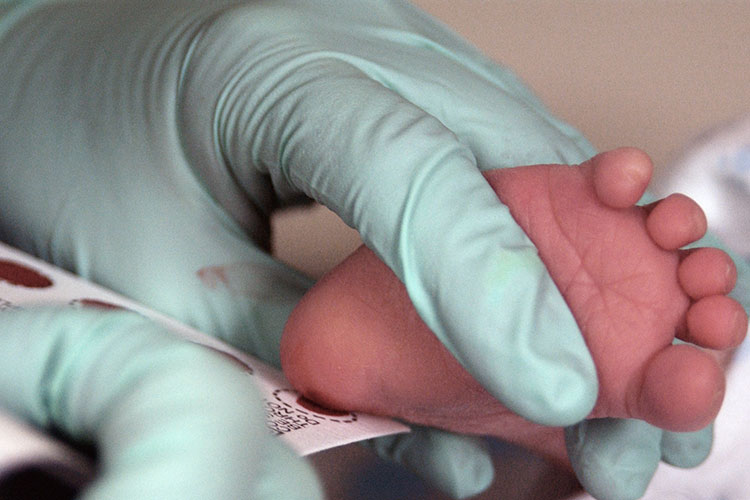Should we sequence newborns’ DNA? The answer is complicated, study finds

Many adults seek genetic counseling, or opt to send samples of their saliva to companies like 23andMe, to find out if the specific patterns in their DNA may put them at higher risk for developing disease. But many doctors and scientists — including National Institutes of Health Director Francis Collins — have predicted that, one day, genetic screening will be a routine health check performed on all newborn babies.
A new study led by researchers at the University of California, Berkeley; the University of California, San Francisco (UCSF); and Tata Consultancy Services is the first to comprehensively assess the potential of genomic sequencing to reveal health problems in newborns. The study, NBseq, compared how genomic sequencing fared against standard biochemical testing in identifying 48 rare metabolic disorders in newborns.
The results, published this week in the journal Nature Medicine, show that, when used alone, sequencing is not as accurate as standard biochemical tests, as it misses some sick babies while tagging many healthy ones as potentially ill.
However, the research team concluded that giving sequence data to doctors examining newborns whose illnesses were flagged by standard testing could aid in more precise and timely diagnoses. After careful vetting, sequencing might also enable screening for hundreds of treatable genetic diseases that currently can’t be detected through biochemical testing.
“Thirty years ago, when I was an undergraduate in the world’s first genome sequencing laboratory, my mentor gave talks predicting that, by 2030 or 2040, every newborn would leave the hospital with their genome on a CD-ROM,” said study co-senior author Steven Brenner, a UC Berkeley professor and a member of UCSF’s Institute for Human Genetics. “This has become increasingly technically plausible, but the value of pervasive newborn sequencing — and the risks — have remained unclear. This work draws on a unique dataset to give unparalleled insight into the implications of sequencing all newborns to identify diseases without current symptoms.”
It may seem surprising that genetic testing doesn’t work as well as other methods for identifying genetic disease. But while the shortcomings of genetic sequencing could have many causes, the value of the technique will likely improve as scientists learn more about the specific genetic variants that lead to disease.
“These are well-studied classic genetic conditions, but that does not mean we have found all the genes associated with them,” said first author Aashish Adhikari, from UC Berkeley’s Department of Plant and Microbial Biology and a member of UCSF’s Institute for Human Genetics. “Additional genes could be involved, as well as additional biological and environmental factors, that may limit our ability to predict disease from DNA sequences alone.”
Sequencing DNA from a decade-old spot of blood
Soon after they are born, every baby in California receives a heel prick, releasing a small sample of blood that is saved on a piece of filter paper. These samples are collected to test for a series of rare metabolic conditions, known as inborn errors of metabolism, that show up as abnormal biochemical signatures. Many of these conditions don’t exhibit clear symptoms right away, but can lead to serious health problems down the road, if left untreated.
Out of nearly 4.5 million newborns born in California between July 2005 to December 2013, more than 1,300 were found to have inborn errors of metabolism. To conduct the study, the team obtained a comprehensive set of de-identified samples from nearly all affected babies. They then optimized a technique to extract and accurately sequence the DNA from the filter paper samples, which had been saved and stored for years.
“When we started, we did not know whether decade-old dried blood spots could generate good quality DNA sequences. If they were degraded, then most of the ‘variants’ in the genome would actually just be errors,” said Rajgopal Srinivasan, chief scientist of the life sciences research area at Tata Consultancy Services. “We worked together to develop a battery of new analyses to confirm that the DNA sequences we found were trustworthy.”
Standard biochemical screenings find 99% of babies with metabolic disorders, while giving a false positive rate of just 0.2%. However, the researchers found that genetic testing alone would have found only 88% of these cases, leaving about 160 babies with a false negative that could lead to serious consequences. It also would have incorrectly identified about 8,000 healthy babies each year as being at risk for disease, leading to unnecessary interventions.
However, the researchers also found cases where the original blood tests were inconclusive, but the results of the DNA sequencing would have allowed them to make a definitive diagnosis.
This kind of accuracy is key in screening tests, the researchers said, as most newborns with these conditions do not show symptoms right away.
“All of the prior studies of utility of exome sequencing have started with a patient already in front of a doctor — in other words, a patient with a problem,” said Dr. Jennifer Puck, professor of pediatrics at UCSF and co-senior author of the study. “You start with a clue in hand, a person with a particular difficulty, and you’re trying to see if there’s an underlying genetic reason for that. When you switch to screening mode, you don’t have any clues. Most newborns look perfectly healthy.”
